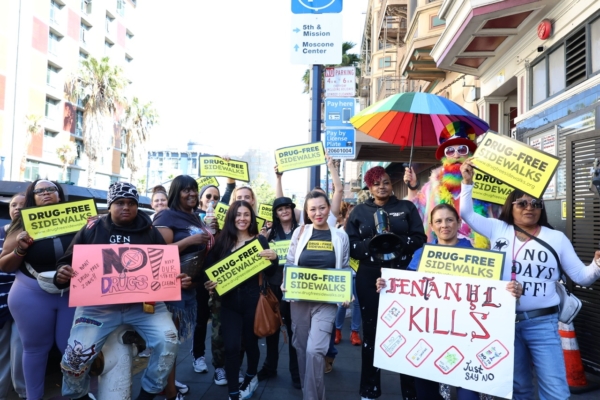On August 27, 2025, a community gathering was held in the South of Market area (SoMa) of San Francisco, where residents called for the creation of safe, drug-free sidewalks.
The event was organized by the nonprofit organization CityTeam San Francisco, the advocacy group “Drug-Free Sidewalks”, local businesses, and community leaders.
The gathering started at the CityTeam San Francisco office on 6th Street, and participants walked to the soon-to-be-opened Eleanora Fagan Stabilization Center. Located at the former Kean Hotel on Mission Street, the center has 70 beds and provides a combination of housing placement and 90-day drug rehabilitation services to help homeless and drug users stabilize physically and mentally, assisting them in transitioning to community living and eventually obtaining supportive housing.
The center is part of the “Breaking the Cycle” initiative led by San Francisco Mayor Daniel Lurie and operated by Westside Community Services.
For a long time, 6th Street has been notorious for open drug dealing and drug use, making the sidewalks unsafe, hampering businesses’ operations, and instilling fear in residents. Previous cleanup efforts and safety patrols were often short-term measures, resulting in fluctuating street conditions and an unresolved issue.
Councilman Matt Dorsey of District 6 emphasized at the gathering that recovery-oriented services are the key to addressing the drug crisis. He stated, “If San Francisco wants to fulfill its promise of drug-free sidewalks and safe streets, it must have robust recovery resources.”
Dorsey, who has personally undergone addiction recovery treatment, firmly believes that such services bring stability and a sense of responsibility. He expressed confidence that a recovery-oriented approach would make San Francisco a city where open drug use on sidewalks is prohibited.
Data provided in the organizers’ press release indicated that drug overdose deaths in permanent supportive housing in San Francisco accounted for 30% of the city’s total drug overdose deaths, surpassing any other location.
Cat Montes, the project manager at CityTeam San Francisco, highlighted the impact of fentanyl on the streets of San Francisco, leading to widespread drug use on sidewalks. Montes expressed the need for change and urged policymakers to designate the area as a “Drug-Free Sidewalk”, for the sake of the community, families, and children.
Participants were called upon to stand together, taking action to promote unity within the community and demand change. The goal is a “Drug-Free Sidewalk”, not only for themselves but for the entire Bay Area.
Alex Ludlum, Executive Director of the SOMA West Community Benefit District, underlined the team’s continuous efforts to enhance the district, making it cleaner, more beautiful, and safer.
Ludlum stated that their team cleans up 800,000 pounds of trash from the streets annually, emphasizing their dedication to a community that others may overlook but they care about. He urged the government to fulfill its commitment by designating the area a “Youth and Families Special Use District”.
Sixteen-year-old resident Ziggy Brown, attending George Washington High School, lamented at the gathering about the prolonged drug problems plaguing his community while authorities have not brought tangible improvements.
Brown emotionally pleaded for a “Drug-Free Sidewalk”, expressing frustration at the lack of change despite his childhood experiences with the issue and seeing his younger sister grow up in the same environment.
He tearfully emphasized the desire for a world where San Francisco’s children can focus on the sky rather than worrying about what lies on the ground, as drugs continue to erode their surroundings. Brown stressed the importance of providing a conducive environment for children to grow and develop.
Dorsey commended Brown’s heartfelt speech, reflecting the sentiments of the entire community. He acknowledged the spontaneous gathering by community residents as a beacon of hope.
Dorsey pledged to continue advocating for relevant legislation at the city council, including a proposal to ban public drug use and promote Drug-Free Sidewalks, which will be put to a public vote next year.
He stressed the need for a dual approach, combining increased recovery resources and drug-free housing options with intensified interventions against public drug use as necessary measures to address the issue effectively.

